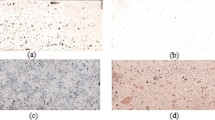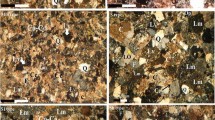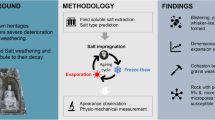Abstract
Persepolis historical complex hosts palaces and tombs which are constructed by stone blocks. These stones suffer from various weathering. Hence, in this study, physico-mechanical properties of Persepolis stone are investigated in relation to some important weathering factors including freezing–thawing, thermal shock and salt crystallization. This study focused on role of the stone petrography on its durability against the weathering factors. Petrography studies showed that the stone is a nonporous-impermeable bioclastic-packstone which suffered significant diagenesis pressures and contain fractures filled by clay. Based on the obtained results, most of the observed deterioration for the stone is related to freezing–thawing cycles. The freezing–thawing cycles induced significant losses in the stone mechanical properties. Similar variations were recorded after the salt crystallization and thermal shock cycles, although the changes in the stone properties were not to the extent of freezing–thawing. Assessing values of decay constant (λ) and half-time (N1/2) obtained for the stone in relation to the ageing test cycles showed that freeze–thaw and thermal shock have more deteriorative effects on the stone durability than salt crystallization. It is suggested that porosity is the main factor that controls the Persepolis stone durability. Low permeability of the stone inhibits water percolation throughout the specimens, so their deterioration against salt crystallization is negligible. But in case of the freeze–thaw cycles, water uptake by clay minerals, which filled diagenesis fractures in the limestone, could be considered as the main factor for the observed deterioration during freezing–thawing. Also, effect of micro-cracks, caused by the thermal shock cycles, is the best explanation for reducing the mechanical properties of the stone.












Similar content being viewed by others
References
Bausch W (1968) Clay content and calcite crystal size of limestones. Sedimentology 10:71–75
Bayram F (2012) Predicting mechanical strength loss of natural stones after freeze–thaw in cold regions. Cold Reg Sci Technol 83:98–102
Benavente D, Martinez-Martinez J, Cueto N, Ordoñez S, Garcia-del-Cura M (2018) Impact of salt and frost weathering on the physical and durability properties of travertines and carbonate tufas used as building material. Environ Earth Sci 77:147
British Standards Institution (1999) Natural stone test methods: determination of resistance to salt crystallization. British Standards Institution
Cardell C, Delalieux F, Roumpopoulos K, Moropoulou A, Auger F, Van Grieken R (2003) Salt-induced decay in calcareous stone monuments and buildings in a marine environment in SW France. Constr Build Mater 17:165–179
Cardell C, Benavente D, Rodríguez-Gordillo J (2008) Weathering of limestone building material by mixed sulfate solutions. Characterization of stone microstructure, reaction products and decay forms. Mater Charact 59:1371–1385
Cárdenes V, Mateos F, Fernández-Lorenzo S (2014) Analysis of the correlations between freeze–thaw and salt crystallization tests. Environ Earth Sci 71:1123–1134
Center UWH (1979) World heritage list, Persepolis. [Online] available from: http://whc.unesco.org/en/list/114. Accessed 20 Mar 2018
D4373-14 A (2014) Standard test method for rapid determination of carbonate content of soils. ASTM International, West Conshohocken
D5312 M-12 AD (2013) Standard Test Method for Evaluation of Durability of Rock for Erosion Control Under Freezing and Thawing Conditions. ASTM International, West Conshohocken
Darvishzadeh A (2009) Geology of Iran: stratigraphy, tectonic, metamorphism, and magmatism. Amir kabir, Tehran
Demirdag S (2013) Effects of freezing–thawing and thermal shock cycles on physical and mechanical properties of filled and unfilled travertines. Constr Build Mater 47:1395–1401
Dunham RJ (1962) Classification of carbonate rocks according to depositional textures. Am Assoc Pet Geol 1:108–121
EN, UNI (2013) Natural stone test methods. Determination of resistance to ageing by thermal shock
Eren Ö, Bahali M (2005) Some engineering properties of natural building cut stones of Cyprus. Constr Build Mater 19:213–222
Eslami J, Walbert C, Beaucour A-L, Bourges A, Noumowe A (2018) Influence of physical and mechanical properties on the durability of limestone subjected to freeze–thaw cycles. Constru Build Mater 162:420–429
Evans IS (1969) Salt crystallization and rock weathering: a review
Fener M, Ince I (2015) Effects of the freeze–thaw (F–T) cycle on the andesitic rocks (Sille-Konya/Turkey) used in construction building. J Afr Earth Sci 109:96–106
Fitzner B, Heinrichs K, La Bouchardiere D (2002) Damage index for stone monuments, pp 315–326. na
Fookes P, Gourley C, Ohikere C (1988) Rock weathering in engineering time. Q J Eng Geol Hydrogeol 21:33–57
Fort R, Fernández-Revuelta B, Varas MJ, De Buergo MÁ, Taborda-Duarte M (2008) Influence of anisotropy on the durability of Madrid-region Cretaceous dolostone exposed to salt crystallization processes. Mater Constr 58:161–178
Franklin J (1985) Suggested method for determining point load strength. Int J Rock Mech Min Sci Geomech Abstr. 22:51–60
Gallello G, Ghorbani S, Ghorbani S, Pastor A, De la Guardia M (2016) Non-destructive analytical methods to study the conservation state of Apadana Hall of Persepolis. Sci Total Environ 544:291–298
Germinario L, Siegesmund S, Maritan L, Mazzoli C (2017) Petrophysical and mechanical properties of Euganean trachyte and implications for dimension stone decay and durability performance. Environ Earth Sci 76:739
Ghanbari MM, Bourghaee SM, Hassani AH, Farjadfard S (2010) Effect of acid rain on environment and Persepolis archaeological zone. J Hum Environ 8:59–66
Ghobadi M, Babazadeh R (2015) Experimental studies on the effects of cyclic freezing–thawing, salt crystallization, and thermal shock on the physical and mechanical characteristics of selected sandstones. Rock Mech Rock Eng 48:1001–1016
Ghobadi M, Torabi-Kaveh M (2014) Assessing the potential for deterioration of limestones forming Taq-e Bostan monuments under freeze–thaw weathering and karst development. Environ Earth Sci 72:5035–5047
Halsey D, Dews S, Mitchell D, Harris F (1995) Real time measurements of sandstone deterioration: a microcatchment study. Build Environ 30:411–417
Hashemi M, Goudarzi MB, Jamshidi A (2018) Experimental investigation on the performance of Schmidt hammer test in durability assessment of carbonate building stones against freeze–thaw weathering. Environ Earth Sci 77:684
Haynes WM (2014) CRC handbook of chemistry and physics. CRC Press, Boca Raton
Heidari M, Torabi-Kaveh M, Chastre C, Ludovico-Marques M, Mohseni H, Akefi H (2017a) Determination of weathering degree of the Persepolis stone under laboratory and natural conditions using fuzzy inference system. Constr Build Mater 145:28–41
Heidari M, Torabi-Kaveh M, Mohseni H (2017b) Assessment of the effects of freeze–thaw and salt crystallization ageing tests on Anahita Temple Stone, Kangavar, West of Iran. Geotech Geol Eng 35:121–136
Jamshidi A, Nikudel MR, Khamehchiyan M (2016) Evaluation of the durability of Gerdoee travertine after freeze–thaw cycles in fresh water and sodium sulfate solution by decay function models. Eng Geol 202:36–43
Jamshidi A, Nikudel M, Khamehchiyan M, Zalooli A, Yeganehfar H (2017) Estimating the mechanical properties of travertine building stones due to salt crystallization using multivariate regression analysis. J Sci Islamic Republ Iran 28:231–241
Karaca Z, Deliormanli AH, Elci H, Pamukcu C (2010) Effect of freeze–thaw process on the abrasion loss value of stones. Int J Rock Mech Min Sci 47:1207–1211
Lezzerini M, Raneri S, Nutarelli M, Luti L (2017) Conservation of cultural stones: relationship among texture, thermal ageing and consolidation strategies in white apuan marbles. J Miner Metal Mater Eng 3:46–57
Lopez-Arce P, Tagnit-Hammou M, Menendez B, Mertz J, Kaci A (2016) Durability of stone-repair mortars used in historic buildings from Paris. Mater Struct 49:5097–5115
Ludovico-Marques M, Chastre C (2012) Effect of salt crystallization ageing on the compressive behavior of sandstone blocks in historical buildings. Eng Fail Anal 26:247–257
Martínez-Martínez J, Benavente D, Gomez-Heras M, Marco-Castaño L, García-del-Cura MÁ (2013) Non-linear decay of building stones during freeze–thaw weathering processes. Constr Build Mater 38:443–454
Marzal RME, Scherer GW (2008) Crystallization of sodium sulfate salts in limestone. Environ Geol 56:605–621
McKinley J, Curran J, Turkington A (2001) Gypsum formation in non-calcareous building sandstone: a case study of Scrabo sandstone. Earth Surf Processes landf 26:869–875
Menéndez B, Petráňová V (2016) Effect of mixed vs single brine composition on salt weathering in porous carbonate building stones for different environmental conditions. Eng Geol 210:124–139
Modestou S, Theodoridou M, Ioannou I (2015) Micro-destructive mapping of the salt crystallization front in limestone. Eng Geol 193:337–347
Mohammadi P, Krumbein WE (2008) Biodeterioration of ancient stone materials from the Persepolis monuments (Iran). Aerobiologia 24:27–33
Mutlutürk M, Altindag R, Türk G (2004) A decay function model for the integrity loss of rock when subjected to recurrent cycles of freezing–thawing and heating–cooling. Int J Rock Mech Min Sci 41:237–244
Noor-E-Khuda S, Albermani F, Veidt M (2017) Flexural strength of weathered granites: influence of freeze and thaw cycles. Constr Build Mater 156:891–901
Pápay Z, Török Á (2018) Effect of Thermal and Freeze–thaw stress on the mechanical properties of porous limestone. Period Polytech Civil Eng 62:423–428
Sadeghiyeh A, Mirrokmi M, Mostafayi-pour A, Hedayattolah R (2015) Role of contamination of Shiraz Petrochemical Complex in abrasion of surface of Persepolis monuments using output of MERCURE–SATURNE model. In: The international conference on new horizons in science management and accounting, economics and entrepreneurship, COI: BCONF01_087 (In Persian)
Severin KP (2004) Energy dispersive spectrometry of common rock forming minerals. Springer, Berlin
Shekofteh A, Molina E, Arizzi A, Cultrone G, Ahmadi H, Yazdi M (2018) Characterization and damage assessment of stones used in the Pasargadae World Heritage Site, Achaemenian period. Int J Arch Herit 13:1–16
Sousa LM, del Río LMS, Calleja L, de Argandona VGR, Rey AR (2005) Influence of microfractures and porosity on the physico-mechanical properties and weathering of ornamental granites. Eng Geol 77:153–168
Taghipour M, Nikudel MR, Farhadian MB (2016) Engineering properties and durability of limestones used in Persepolis complex, Iran, against acid solutions. Bull Eng Geol Environ 75:967–978
Takarli M, Prince W, Siddique R (2008) Damage in granite under heating/cooling cycles and water freeze–thaw condition. Int J Rock Mech Min Sci 45:1164–1175
Ugur I, Sengun N, Demirdag S, Altindag R (2014) Analysis of the alterations in porosity features of some natural stones due to thermal effect. Ultrasonics 54:1332–1336
Ulusay R (ed) (2014) The ISRM suggested methods for rock characterization, testing and monitoring: 2007–2014. Springer
Vázquez P, Menéndez B, Denecker MF, Thomachot-Schneider C (2016) Comparison between petrophysical properties, durability and use of two limestones of the Paris region. Geol Soc Lond Spec Publ 416:203–216
Walbert C, Eslami J, Beaucour A-L, Bourges A, Noumowe A (2015) Evolution of the mechanical behaviour of limestone subjected to freeze–thaw cycles. Environ Earth Sci 74:6339–6351
Wang P, Xu J, Fang X, Wen M, Zheng G, Wang P (2017) Dynamic splitting tensile behaviors of red-sandstone subjected to repeated thermal shocks: deterioration and micro-mechanism. Eng Geol 223:1–10
Wang L, Li N, Qi J, Tian Y, Xu S (2018) Study on changes in integrity decay of sandstone subjected to freeze–thaw cycling. In: proceedings of China–Europe conference on geotechnical engineering. Springer. Berlin, pp 1420–1423
Weiss T, Siegesmund S, Fuller ER (2003) Thermal degradation of marble: indications from finite-element modelling. Build Environ 38:1251–1260
Winkler EM (1987) Weathering and weathering rates of natural stone. Environ Geol 9:85–92
Yavuz H (2011) Effect of freeze–thaw and thermal shock weathering on the physical and mechanical properties of an andesite stone. Bull Eng Geol Environ 70:187–192
Yavuz A, Topal T (2007) Thermal and salt crystallization effects on marble deterioration: examples from Western Anatolia, Turkey. Eng Geol 90:30–40
Yavuz H, Altindag R, Sarac S, Ugur I, Sengun N (2006) Estimating the index properties of deteriorated carbonate rocks due to freeze–thaw and thermal shock weathering. Int J Rock Mech Min Sci 43:767–775
Yavuz AB, Akal C, Türk N, Çolak M, Tanyu BF (2015) Investigation of discrepancy between tuff used as building stones in historical and modern buildings in western Turkey. Constr Build Mater 93:439–448
Zalooli A, Freire-Lista DM, Khamehchiyan M, Nikudel MR, Fort R, Ghasemi S (2018) Ghaleh-khargushi rhyodacite and Gorid andesite from Iran: characterization, uses, and durability. Environ Earth Sci 77:315
Zedef V, Kocak K, Doyen A, Ozsen H, Kekec B (2007) Effect of salt crystallization on stones of historical buildings and monuments, Konya, Central Turkey. Build Environ 42:1453–1457
Acknowledgements
The authors convey their sincere thankfulness to Dr. Mohammad Ali Moosavizadeh from Yazd University for advice on sedimentology subjects.
Author information
Authors and Affiliations
Corresponding author
Additional information
Publisher's Note
Springer Nature remains neutral with regard to jurisdictional claims in published maps and institutional affiliations.
Rights and permissions
About this article
Cite this article
Torabi-Kaveh, M., Heidari, M., Mohseni, H. et al. Role of petrography in durability of limestone used in construction of Persepolis complex subjected to artificial accelerated ageing tests. Environ Earth Sci 78, 297 (2019). https://doi.org/10.1007/s12665-019-8308-y
Received:
Accepted:
Published:
DOI: https://doi.org/10.1007/s12665-019-8308-y




